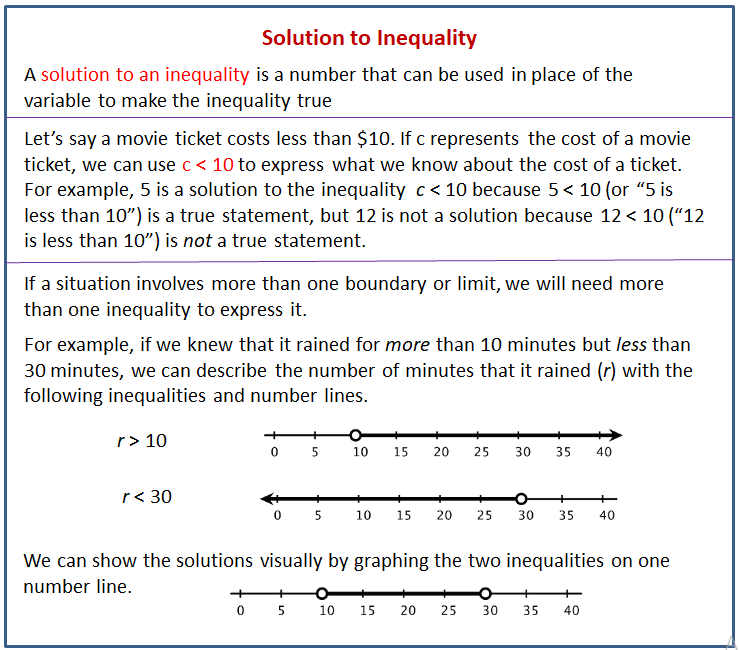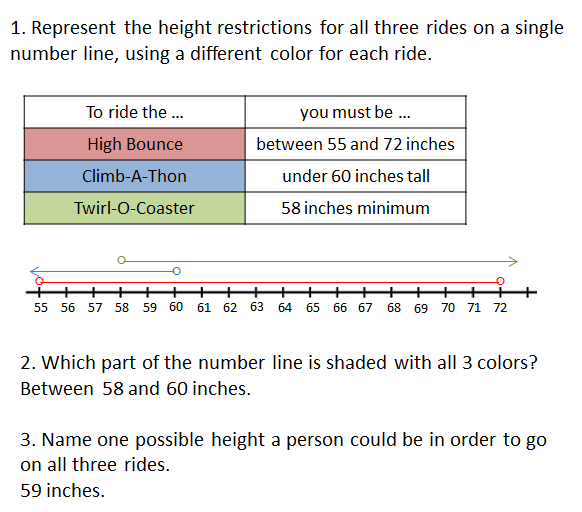Illustrative Mathematics Unit 6.7, Lesson 9: Solutions of Inequalities
Learning Targets:
- I can determine if a particular number is a solution to an inequality.
- I can explain what it means for a number to be a solution to an inequality.
- I can graph the solutions to an inequality on a number line.
Related Pages
Illustrative Math
Grade 6
Lesson 9: Solutions of Inequalities
Let’s think about the solutions to inequalities.
Illustrative Math Unit 6.7, Lesson 9 (printable worksheets)
Lesson 9 Summary
The following diagram shows examples of how to find solutions of inequalities.

Lesson 9.1 Unknowns on a Number Line
The number line shows several points, each labeled with a letter.
- Fill in each blank with a letter so that the inequality statements are true.
a. _______ > _______
b. _______ < _______ - Jada says that she found three different ways to complete the first question correctly. Do you think this is possible? Explain your reasoning.
- List a possible value for each letter on the number line based on its location.
Scroll down the page for the solutions to the “Are you ready for more?” section.
Lesson 9.2 Amusement Park Rides
Priya finds these height requirements for some of the rides at an amusement park.
| to ride the ... | you must be ... |
| High Bounce | between 55 and 72 inches tall |
| Climb-A-Thon | under 60 inches tall |
| Twirl-O-Coaster | 58 inches minimum |
1. Write an inequality for each of the three height requirements. Use h for the unknown height. Then, represent each height requirement on a number line.
Pause here for additional instructions from your teacher.
2. Han’s cousin is 55 inches tall. Han doesn’t think she is tall enough to ride the High Bounce, but Kiran believes that she is tall enough. Do you agree with Han or Kiran? Be prepared to explain your reasoning. 3. Priya can ride the Climb-A-Thon, but she cannot ride the High Bounce or the Twirl-O-Coaster. Which, if any, of the following could be Priya’s height? Be prepared to explain your reasoning.
59 inches
53 inches
56 inches
4. Jada is 56 inches tall. Which rides can she go on? 5. Kiran is 60 inches tall. Which rides can he go on? 6. The inequalities h < 75 and h > 64 represent the height restrictions, in inches, of another ride. Write three values that are solutions to both of these inequalities.
Are you ready for more?
- Represent the height restrictions for all three rides on a single number line, using a different color for each ride.
- Which part of the number line is shaded with all 3 colors?
- Name one possible height a person could be in order to go on all three rides.
Lesson 9.3 What Number Am I?
Your teacher will give your group two sets of cards—one set shows inequalities and the other shows numbers. Arrange the inequality cards face up where everyone can see them. Stack the number cards face down and shuffle them.
To play:
- Nominate one member of your group to be the detective. The other three players are clue givers.
- One clue giver picks a number from the stack and shows it only to the other clue givers. Each clue giver then chooses an inequality that will help the detective identify the unknown number.
- The detective studies the inequalities and makes three guesses.
- If the detective cannot guess the number correctly, the clue givers must choose an additional inequality to help. Add as many inequalities as needed to help the detective identify the correct number.
- When the detective succeeds, a different group member becomes the detective and everyone else is a clue giver.
- Repeat the game until everyone has had a turn playing the detective.
Glossary Terms
solution to an inequality
A solution to an inequality is a number that can be used in place of the variable to make the inequality true.
For example, 5 is a solution to the inequality c < 10, because it is true that 5 < 10. Some other solutions to this inequality are 9.9, 0, and -4.
Lesson 9 Practice Problems
- a. Select all numbers that are solutions to the inequality k > 5.
i. 4
ii. 5
iii. 6
iv. 5.2
v. 5.01
vi. 0.5
b. Draw a number line to represent this inequality. - A sign on the road says: “Speed limit, 60 miles per hour.”
a. Let s be the speed of a car. Write an inequality that matches the information on the sign.
b. Draw a number line to represent the solutions to the inequality.
c. Could 60 be a value of s? Explain your reasoning. - One day in Boston, MA, the high temperature was 60 degrees Fahrenheit, and the low temperature was 52 degrees.
a. Write one or more inequalities to describe the temperatures that are between the high and low temperature on that day.
b. Show the possible temperatures on a number line. - Select all the true statements.
A. -5 < |-5|
B. |-6| < -5
C. |-6| < 3
D. 4 < |-7|
E. |-7| < |-8| - Match each equation to its solution.
The Open Up Resources math curriculum is free to download from the Open Up Resources website and is also available from Illustrative Mathematics.
Try out our new and fun Fraction Concoction Game.
Add and subtract fractions to make exciting fraction concoctions following a recipe. There are four levels of difficulty: Easy, medium, hard and insane. Practice the basics of fraction addition and subtraction or challenge yourself with the insane level.

We welcome your feedback, comments and questions about this site or page. Please submit your feedback or enquiries via our Feedback page.
